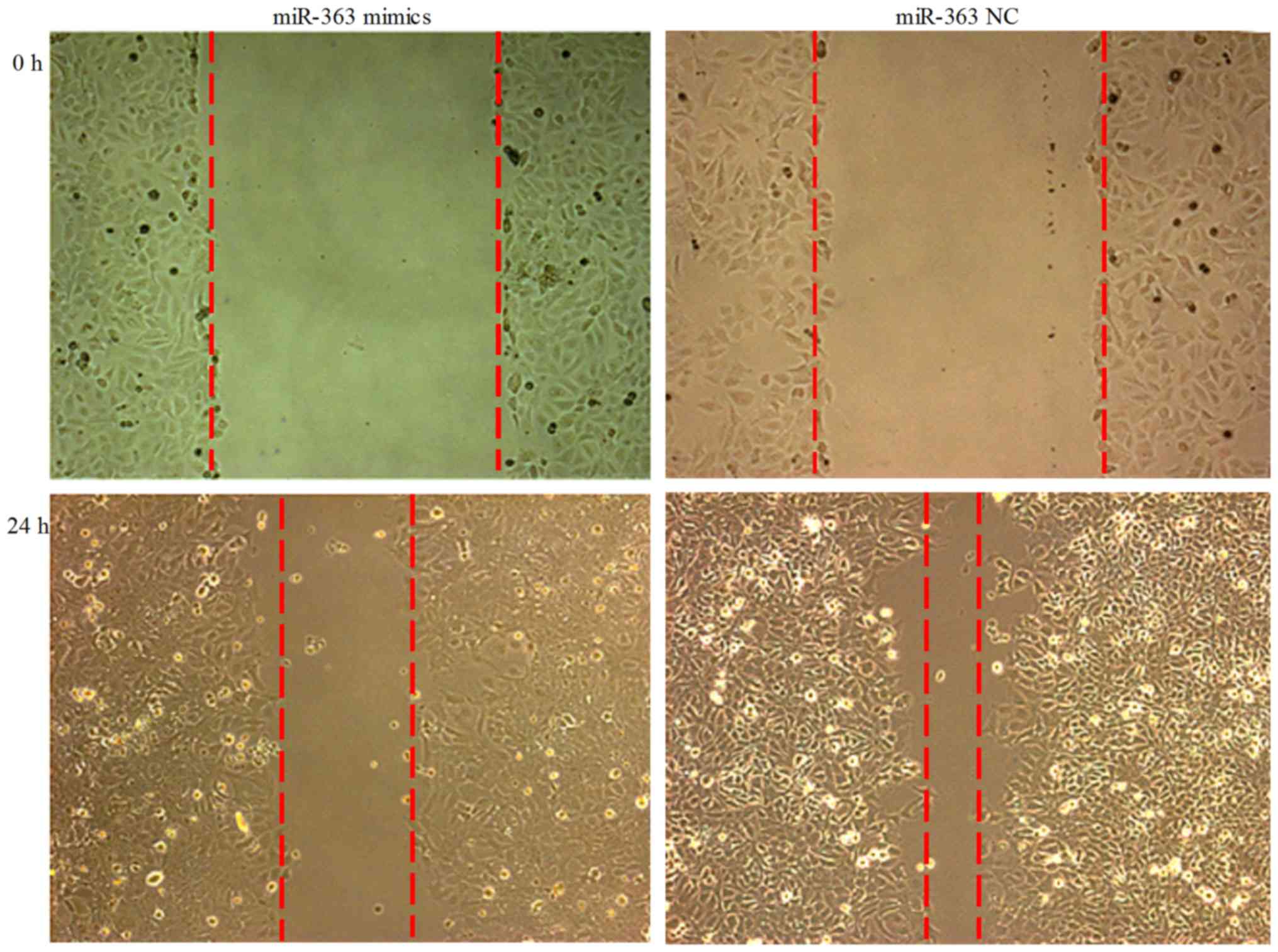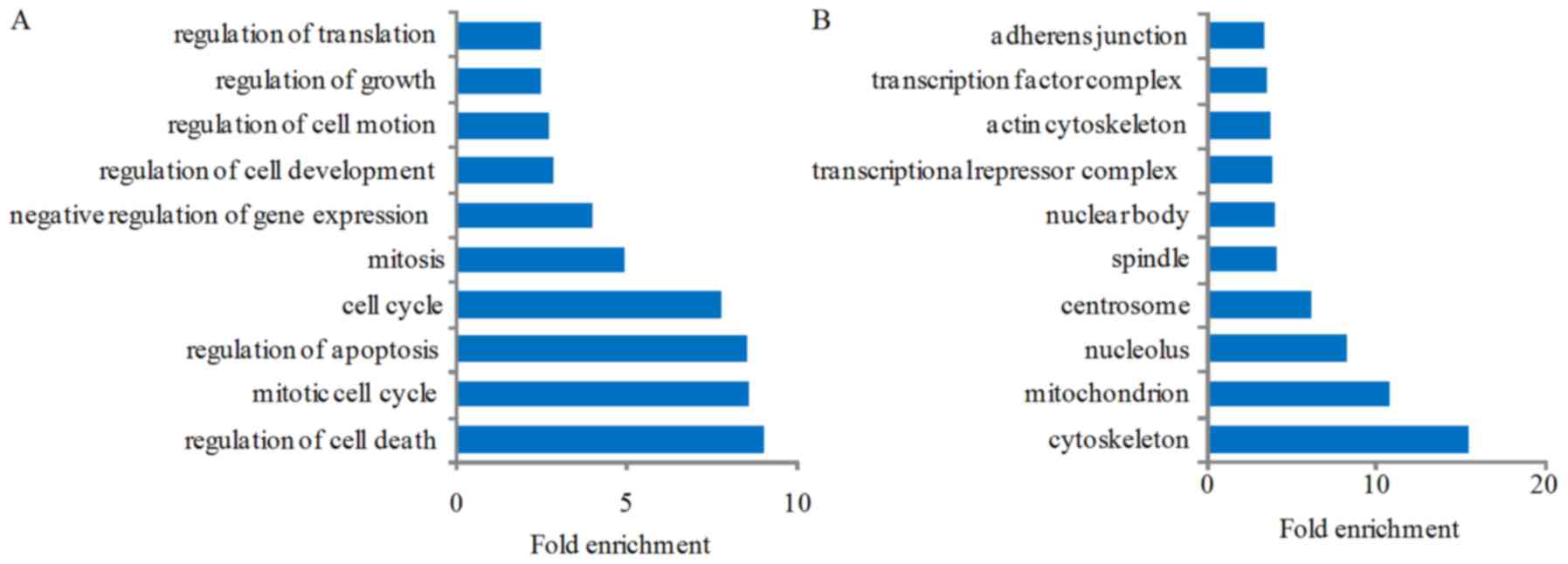|
1
|
Jiang QY and Wu RJ: Growth mechanisms of
endometriotic cells in implanted places: a review. Gynecol
Endocrinol. 28:562–567. 2012. View Article : Google Scholar : PubMed/NCBI
|
|
2
|
Gao X, Outley J, Botteman M, Spalding J,
Simon JA and Pashos CL: Economic burden of endometriosis. Fertil
Steril. 86:1561–1572. 2006. View Article : Google Scholar : PubMed/NCBI
|
|
3
|
Sampson J: Peritoneal endometriosis due to
menstrual dissemination of endometrial tissue into the peritoneal
cavity. Am J Obstet Gynecol. 14:422–469. 1927. View Article : Google Scholar
|
|
4
|
Nair AS, Nair HB, Lucidi RS, Kirchner AJ,
Schenken RS, Tekmal RR and Witz CA: Modeling the early
endometriotic lesion: mesothelium-endometrial cell co-culture
increases endometrial invasion and alters mesothelial and
endometrial gene transcription. Fertil Steril. 90(Suppl 4):
1487–1495. 2008. View Article : Google Scholar : PubMed/NCBI
|
|
5
|
Bartel DP: MicroRNAs: genomics,
biogenesis, mechanism, and function. Cell. 116:281–297. 2004.
View Article : Google Scholar : PubMed/NCBI
|
|
6
|
Okamoto M, Nasu K, Abe W, Aoyagi Y, Kawano
Y, Kai K, Moriyama M and Narahara H: Enhanced miR-210 expression
promotes the pathogenesis of endometriosis through activation of
signal transducer and activator of transcription 3. Hum Reprod.
30:632–641. 2015. View Article : Google Scholar
|
|
7
|
Teague EM, Print CG and Hull ML: The role
of microRNAs in endometriosis and associated reproductive
conditions. Hum Reprod Update. 16:142–165. 2010. View Article : Google Scholar
|
|
8
|
Ohlsson Teague EM, Van der Hoek KH, Van
der hoek MB, Perry N, Wagaarachchi P, Robertson SA, Print CG and
Hull LM: MicroRNA-regulated pathways associated with endometriosis.
Mol Endocrinol. 23:265–275. 2009. View Article : Google Scholar
|
|
9
|
Pan Q, Luo X, Toloubeydokhti T and Chegini
N: The expression profile of micro-RNA in endometrium and
endometriosis and the influence of ovarian steroids on their
expression. Mol Hum Reprod. 13:797–806. 2007. View Article : Google Scholar : PubMed/NCBI
|
|
10
|
Chen K and Rajewsky N: The evolution of
gene regulation by transcription factors and microRNAs. Nat Rev
Genet. 8:93–103. 2007. View
Article : Google Scholar : PubMed/NCBI
|
|
11
|
Lv J, Fu Z, Shi M, Xia K, Ji C, Xu P, Lv
M, Pan B, Dai L and Xie H: Systematic analysis of gene expression
pattern in has-miR-760 overexpressed resistance of the MCF-7 human
breast cancer cell to doxorubicin. Biomed Pharmacother. 69:162–169.
2015. View Article : Google Scholar : PubMed/NCBI
|
|
12
|
Huang W, Sherman BT and Lempicki RA:
Systematic and integrative analysis of large gene lists using DAVID
bioinformatics resources. Nat Protoc. 4:44–57. 2009. View Article : Google Scholar
|
|
13
|
Yu J, Wang Y, Zhou WH, Wang L, He YY and
Li DJ: Combination of estrogen and dioxin is involved in the
pathogenesis of endometriosis by promoting chemokine secretion and
invasion of endometrial stromal cells. Hum Reprod. 23:1614–1626.
2008. View Article : Google Scholar
|
|
14
|
De La Garza EM, Binkley PA, Ganapathy M,
Krishnegowda NK, Tekmal RR, Schenken RS and Kirma NB: Raf-1, a
potential therapeutic target, mediates early steps in endometriosis
lesion development by endometrial epithelial and stromal cells.
Endocrinology. 153:3911–3921. 2012. View Article : Google Scholar : PubMed/NCBI
|
|
15
|
Li MQ, Li HP, Meng YH, Wang XQ, Zhu XY,
Mei J and Li DJ: Chemokine CCL2 enhances survival and invasiveness
of endometrial stromal cells in an autocrine manner by activating
Akt and MAPK/Erk1/2 signal pathway. Fertil Steril. 97:919–929.
2012. View Article : Google Scholar : PubMed/NCBI
|
|
16
|
Tapia-Pizarro A, Argandoña F, Palomino WA
and Devoto L: Human chorionic gonadotropin (HCG) modulation of
TIMP1 secretion by human endometrial stromal cells facilitates
extravillous trophoblast invasion in vitro. Hum Reprod.
28:2215–2227. 2013. View Article : Google Scholar : PubMed/NCBI
|
|
17
|
Sun Q, Zhang J, Cao W, Wang X, Xu Q, Yan
M, Wu X and Chen W: Dysregulated miR-363 affects head and neck
cancer invasion and metastasis by targeting podoplanin. Int J
Biochem Cell Biol. 45:513–520. 2013. View Article : Google Scholar
|
|
18
|
Qiao J, Lee S, Paul P, Theiss L, Tiao J,
Qiao L, Kong A and Chung DH: miR-335 and miR-363 regulation of
neuroblastoma tumorigenesis and metastasis. Surgery. 154:226–233.
2013. View Article : Google Scholar : PubMed/NCBI
|
|
19
|
Vernet-Tomás MM, Pérez-Ares CT, Verdú N,
Fernández-Figueras MT, Molinero JL and Carreras R: The depolarized
expression of the alpha-6 integrin subunit in the endometria of
women with endometriosis. J Soc Gynecol Investig. 13:292–296. 2006.
View Article : Google Scholar
|
|
20
|
Giannelli G, Sgarra C, Di Naro E, Lavopa
C, Angelotti U, Tartagni M, Simone O, Trerotoli P, Antonaci S and
Loverro G: Endometriosis is characterized by an impaired
localization of laminin-5 and alpha3beta1 integrin receptor. Int J
Gynecol Cancer. 17:242–247. 2007. View Article : Google Scholar : PubMed/NCBI
|
|
21
|
Lin SC, Wang CC, Wu MH, Yang SH, Li YH and
Tsai SJ: Hypoxia-induced microRNA-20a expression increases ERK
phosphorylation and angiogenic gene expression in endometriotic
stromal cells. J Clin Endocrinol Metab. 97:E1515–E1523. 2012.
View Article : Google Scholar : PubMed/NCBI
|
|
22
|
Wu MH, Wang CA, Lin CC, Chen LC, Chang WC
and Tsai SJ: Distinct regulation of cyclooxygenase-2 by
interleukin-1beta in normal and endometriotic stromal cells. J Clin
Endocrinol Metab. 90:286–295. 2005. View Article : Google Scholar
|
|
23
|
Carli C, Metz CN, Al-Abed Y, Naccache PH
and Akoum A: Up-regulation of cyclooxygenase-2 expression and
prostaglandin E2 production in human endometriotic cells
by macrophage migration inhibitory factor: involvement of novel
kinase signaling pathways. Endocrinology. 150:3128–3137. 2009.
View Article : Google Scholar : PubMed/NCBI
|
|
24
|
Tamura M, Sebastian S, yang S, Gurates B,
Fang Z and Bulun SE: Interleukin-1beta elevates cyclooxygenase-2
protein level and enzyme activity via increasing its mRNA stability
in human endometrial stromal cells: an effect mediated by
extracellularly regulated kinases 1 and 2. J Clin Endocrinol Metab.
87:3263–3273. 2002.PubMed/NCBI
|
|
25
|
Chuang PC, Sun HS, Chen TM and Tsai SJ:
Prostaglandin E2 induces fibroblast growth factor 9 via
EP3-dependent protein kinase Cdelta and Elk-1 signaling. Mol Cell
Biol. 26:8281–8292. 2006. View Article : Google Scholar : PubMed/NCBI
|
|
26
|
Xu X, Zheng Q, Zhang Z, Zhang X, Liu R and
Liu P: Periostin enhances migration, invasion, and adhesion of
human endometrial stromal cells through integrin-linked kinase
1/Akt signaling pathway. Reprod Sci. 22:1098–1106. 2015. View Article : Google Scholar : PubMed/NCBI
|
|
27
|
Li J, Zhang H, Wu J, Guan H, Yuan J, Huang
Z and Li M: Prognostic significance of integrin-linked kinase1
overexpression in astrocytoma. Int J Cancer. 126:1436–1444.
2010.
|
|
28
|
Yin X, Pavone ME, Lu Z, Wei J and Kim JJ:
Increased activation of the PI3K/AKT pathway compromises
decidualization of stromal cells from endometriosis. J Clin
Endocrinol Metab. 97:E35–E43. 2012. View Article : Google Scholar :
|
|
29
|
Samartzis EP, Noske A, Dedes KJ, Fink D
and Imesch P: ARID1A mutations and PI3K/AKT pathway alterations in
endometriosis and endometriosis-associated ovarian carcinomas. Int
J Mol Sci. 14:18824–18849. 2013. View Article : Google Scholar : PubMed/NCBI
|
|
30
|
Franco-Murillo Y, Miranda-Rodríguez JA,
Rendón-Huerta E, Montaño LF, Cornejo GV, Gómez LP, Valdez-Morales
FJ, Gonzalez-Sanchez I and Cerbón M: Unremitting cell proliferation
in the secretory phase of eutopic endometriosis: involvement of
pAkt and pGSK3β. Reprod Sci. 22:502–510. 2015. View Article : Google Scholar
|
|
31
|
Pan Q and Chegini N: MicroRNA signature
and regulatory functions in the endometrium during normal and
disease states. Semin Reprod Med. 26:479–493. 2008. View Article : Google Scholar : PubMed/NCBI
|
|
32
|
Harada T, Taniguchi F, Izawa M, Ohama Y,
Takenaka Y, Tagashira Y, Ikeda A, Watanabe A, Iwabe T and Terakawa
N: Apoptosis and endometriosis. Front Biosci. 12:3140–3151. 2007.
View Article : Google Scholar : PubMed/NCBI
|
|
33
|
Brosens JJ and Gellersen B: Death or
survival - progesterone-dependent cell fate decisions in the human
endometrial stroma. J Mol Endocrinol. 36:389–398. 2006. View Article : Google Scholar : PubMed/NCBI
|
|
34
|
Kao LC, Tulac S, Lobo S, Imani B, Yang JP,
Germeyer A, Osteen K, Taylor RN, Lessey BA and Giudice LC: Global
gene profiling in human endometrium during the window of
implantation. Endocrinology. 143:2119–2138. 2002. View Article : Google Scholar : PubMed/NCBI
|
|
35
|
Jovanovic M and Hengartner MO: miRNAs and
apoptosis: RNAs to die for. Oncogene. 25:6176–6187. 2006.
View Article : Google Scholar : PubMed/NCBI
|
|
36
|
Matsubara H, Takeuchi T, Nishikawa E,
Yanagisawa K, Hayashita Y, Ebi H, Yamada H, Suzuki M, Nagino M,
Nimura Y, et al: Apoptosis induction by antisense oligonucleotides
against miR-17-5p and miR-20a in lung cancers overexpressing
miR-17-92. Oncogene. 26:6099–6105. 2007. View Article : Google Scholar : PubMed/NCBI
|
|
37
|
Mertens-Talcott SU, Chintharlapalli S, Li
X and Safe S: The oncogenic microRNA-27a targets genes that
regulate specificity protein transcription factors and the G2-M
checkpoint in MDA-MB-231 breast cancer cells. Cancer Res.
67:11001–11011. 2007. View Article : Google Scholar : PubMed/NCBI
|
|
38
|
Xu YL, Wang DB, Liu QF, Chen YH and Yang
Z: Silencing of cofilin-1 gene attenuates biological behaviours of
stromal cells derived from eutopic endometria of women with
endometriosis. Hum Reprod. 25:2480–2488. 2010. View Article : Google Scholar : PubMed/NCBI
|
|
39
|
Absenger Y, Hess-Stumpp H, Kreft B,
Krätzschmar J, Haendler B, Schütze N, Regidor PA and Winterhager E:
Cyr61, a deregulated gene in endometriosis. Mol Hum Reprod.
10:399–407. 2004. View Article : Google Scholar : PubMed/NCBI
|
|
40
|
Hull ML, Escareno CR, Godsland JM, Doig
JR, Johnson CM, Phillips SC, Smith SK, Tavaré S, Print CG and
Charnock-Jones DS: Endometrial-peritoneal interactions during
endometriotic lesion establishment. Am J Pathol. 173:700–715. 2008.
View Article : Google Scholar : PubMed/NCBI
|













